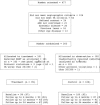Visual functioning and quality of life in the SubFoveal Radiotherapy Study (SFRADS): SFRADS report 2
- PMID: 16024863
- PMCID: PMC1772760
- DOI: 10.1136/bjo.2003.030445
Visual functioning and quality of life in the SubFoveal Radiotherapy Study (SFRADS): SFRADS report 2
Abstract
Aims: To determine whether or not self reported visual functioning and quality of life in patients with choroidal neovascularisation caused by age related macular degeneration (AMD) is better in those treated with 12 Gy external beam radiotherapy in comparison with untreated subjects.
Methods: A multicentre single masked randomised controlled trial of 12 Gy of external beam radiation therapy (EBRT) delivered as 6 x 2 Gy fractions to the macula of an affected eye versus observation. Patients with AMD, aged 60 years or over, in three UK hospital units, who had subfoveal CNV and a visual acuity equal to or better than 6/60 (logMAR 1.0).
Methods: Data from 199 eligible participants who were randomly assigned to 12 Gy teletherapy or observation were available for analysis. Visual function assessment, ophthalmic examination, and fundus fluorescein angiography were undertaken at baseline and at 3, 6, 12, and 24 months after study entry. To assess patient centred outcomes, subjects were asked to complete the Daily Living Tasks Dependent on Vision (DLTV) and the SF-36 questionnaires at baseline, 6, 12, and 24 months after enrolment to the study. Cross sectional and longitudinal analyses were conducted using arm of study as grouping variable. Regression analysis was employed to adjust for the effect of baseline co-variates on outcome at 12 months and 24 months.
Results: Both control and treated subjects had significant losses in visual functioning as seen by a progressive decline in mean scores in the four dimensions of the DLTV. There were no statistically significant differences between treatment and control subjects in any of dimensions of the DLTV at 12 months or 24 months after study entry. Regression analysis confirmed that treatment status had no effect on the change in DLTV dimensional scores.
Conclusions: The small benefits noted in clinical measures of vision in treated eyes did not translate into better self reported visual functioning in patients who received treatment when compared with the control arm. These findings have implications for the design of future clinical trials and studies.
Figures
References
-
- Elliott DB, Hurst MA, Weatherill J. Comparing clinical tests of visual function in cataract with the patient’s perceived visual disability. Eye 1990;4:712–17. - PubMed
-
- Cincotti A. Evaluation of indications of cataract surgery. Ophthalmic Surg 1979;10:25. - PubMed
-
- Bernth-Petersen P. Visual functioning in cataract patients: methods for measuring and results. Acta Ophthalmol 1981;59:198–205. - PubMed
-
- Mangione CM, Phillips RS, Seddon JM, et al. Development of the activities of daily vision scale. A measure of visual function status. Med Care 1992;30:1111–25. - PubMed
-
- Steinberg EP, Tielsch JM, Schein OD, et al. The VF14, an index of functional impairment in patients with cataract. Arch Ophthalmol 1994;112:630–8. - PubMed
Publication types
MeSH terms
LinkOut - more resources
Full Text Sources
Medical

